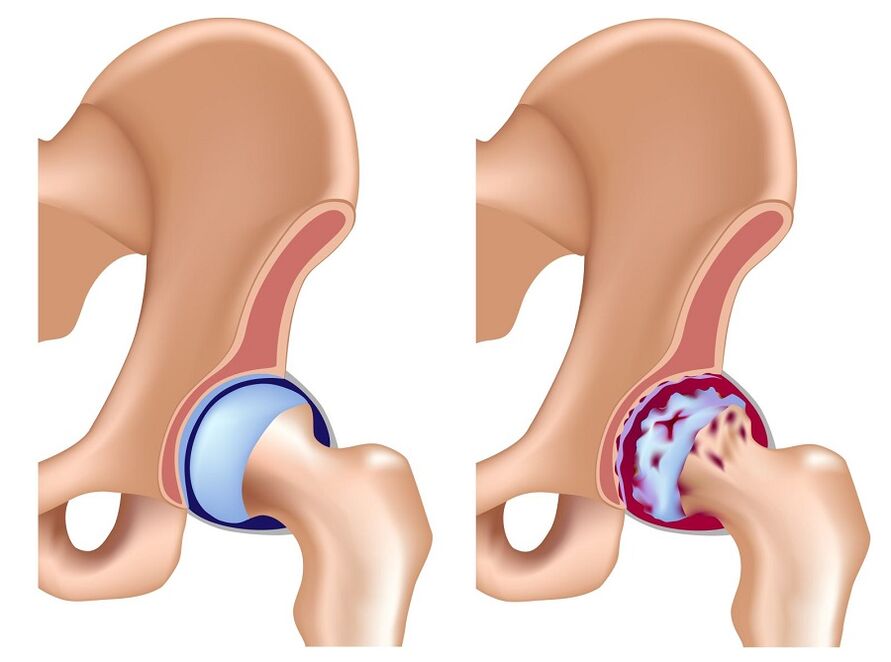Hip arthritis or coxarthrosis is a chronic form of arthritis that causes destruction of cartilage tissue in the joints, exposure of the bones and joints, and joint deformation.The disease is classified as very serious, as amputation or prosthetics may be indications for treatment.

disease cause
The main factors leading to the disease are:
- Severe damage and injury.affects the buttocks;
- Excess weight or a lifestyle that puts severe stress on the hip joints.
- Necrosis of joint tissue, which may be caused by infection, alcohol or drug abuse.
- Postpartum injuries and congenital pathological aberrations of bone tissue.
- Inflammatory process of joints.
- Age-related changes in bone and joint structure.
- Osteoporosis is a pathology associated with the destruction of bone tissue.
Degree and signs of hip arthritis
According to the medical history (medical history), arthrosis occurs in three consecutive stages.
1st degree hip arthritis
The first level is filled with the fact that joint fluid or synovial fluid loses its properties as a lubricant that fills the joint capsule.The cartilage tissue gradually wears away and begins to be replaced by bone formations called osteophytes.
The cure rate for first-level cases is 100%, but patients rarely come to the hospital due to unclear symptoms.If you experience pain in your buttocks that radiates to your groin when walking or lifting heavy objects, you should see your doctor immediately.
Level 2
At this stage, damage to joint tissue is more active.The amount of bone growth increases and the cartilage layer becomes significantly thinner.X-ray showed inflammation of the periosteal portion.Initial symptoms worsen: the pain syndrome worsens, peak pain occurs at night or at dawn, and walking and gait are impaired.The joints begin to gradually deform.
Level three
In the third stage, the cartilage tissue disappears completely.Movement of the legs was completely restricted and even powerful anesthetics failed to relieve the pain.Indications for treatment are amputation at the hip joint or replacement of the joint with a prosthesis.
diagnosis
The initial stages of treating hip joint disease are prompt diagnosis and taking a medical history (medical history).If diagnosed early, the disease can be cured or significantly delayed.
The most important way to detect the disease is X-ray examination.Examination of the patient, external signs, and tests are secondary preliminary measures that complement the overall picture of the history.
therapeutic treatment
It should be noted that doctors give a straight answer on how to treat hip joints.The first and second degrees can be treated, and the third degree can be treated surgically.
The following therapies are used for outpatient treatment:
- anesthetic;
- anti-inflammatory drugs;
- Compression and the drug "Dimexide" - a cartilage restorer, similar injections are also used;
- Physiotherapy, gymnastics, exercise therapy, diet.
All methods must be used in a coordinated manner, otherwise the treatment will not be effective.
Massage helps relieve severe muscle spasms and malnutrition, as the massage maneuvers restore lymphatic exchange and activate blood supply.Massage is used in the first phase after relief of the main symptoms: pain, tumors, inflammatory processes in the joints.
A similar remedy to massage could be to take a muscle relaxant - medication that reduces and relaxes muscle tension.
For medical treatment, doctors prescribe painkillers, gels and ointments that do not contain steroid derivatives.The use of steroids can cause lumps and severe bone growth in the damaged tissue as the steroids begin to replace the missing material in synovitis.
Proper nutrition and diet
A balanced diet helps the body get the complex nutrients and trace elements it needs to "build" joint tissue.The main task of using the diet is to provide the body with proteins needed for the structure of muscle tissue and cartilage; calcium is also necessary for the structure of bones and synovial fluid; this diet helps patients remove salt deposits from the joints and lose weight, which adversely affects joints and bone joints.
Recommendations and indications:
- It is necessary to consume a balanced and moderate amount of protein (poultry, beef, fish).Preserved meats and vegetables are prohibited;
- fresh dairy products, cheese;
- Sweets and starchy foods must be excluded from the diet;
- Preference is given to cereal porridge cooked in water;
- You need to start eating five different vegetables every day;
- Break bad habits completely;
- To normalize your metabolism, you need to eat small, frequent meals.
The diet will significantly reduce the load on the joints, as the body will lose excess weight and will also create the prerequisites for tissue recovery.
Hip arthritis is a very serious condition, filled with pain and the loss of a leg, but it can be treated very effectively.You just need to seek medical treatment in time, have regular physical examinations, and be able to "listen" to your body.A combination of treatments will be effective and the body will heal.
























